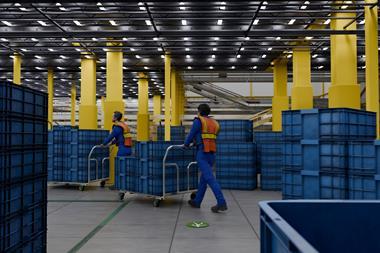While no retail warehouse can be perfect because of continual changes, ensuring your distribution centre is adaptable will mean it can be as efficient as possible, says Liz Morrell
In today’s world of stockroom-free stores and just-in-time delivery models, a smooth-running, highly efficient distribution centre is business critical. But this most important element of the supply chain is often neglected.
Supply chain consultancy Davies & Robson director Nick Weetman says: “The efficiency of a warehouse is often overlooked. Retailers will look at
lorries and fleet but the warehouse is often a big box in a yard somewhere that gets forgotten.” When supply chains become inefficient, the consequences are dramatic. “When they go wrong the effect is almost instantaneous, and if they are inefficient then those inefficiencies during peak trading are multiplied,” he says.
Blend processes
Claire’s Europe supply chain vice-president Steve Williams says improving efficiency is about a blend of processes. These are wide ranging and include people spending less time walking around the DC unnecessarily and equipment being moved less, maximising storage capacity, good supervision to keep staff productive and focused, getting as many tasks completed during the day shift as possible to reduce shift premium payments, and planning goods in deliveries so that labour and equipment are used to the maximum efficiency.
He also advises maximising movements in pallet storage areas and planning the routing of trucks to ensure they carry a load on as many journeys as possible. But one of the most common causes of inefficiency in a retailer’s distribution centre is the fact that stores and business models have changed over the years, while the warehouse has not.
Kenneth Porter, partner at supply chain consultancy Total Logistics, says it is common that a business evolves and the product range and service offer changes, but no one thinks to change the warehouse. “You often see a retailer changing their business plan to have bigger or smaller stores, for example, and those sorts of things have a big impact on the supply chain and warehouse,” he says. To help cope with that, retailers should prepare for the unexpected and install a flexible solution that can adapt to changing requirements.
Gist third-party logistics development controller Brian Turner says: “Most businesses don’t end up looking like what they were expected to – things like product ranges and acquisitions can cause big problems.” Instead of designing rigidly around what you anticipate your business will be, it is wise to test the plan. “What if your product ranges or volumes go up by 10% or 20%, or what if you want to develop your business in another region?” asks Turner. “Test it and test it to see when it breaks, then think: ‘What are my options when it does start to break?’”
Wincanton UK managing director of retail operations Les Flanagan agrees. “You have to design your warehouse with flexibility in mind, bearing in mind that what you do will be totally different in five years’ time,” he says. “You have to keep it as simple as possible.”
It is also wise to continually monitor and adjust the warehouse operations. Tesco.com supply chain director Neil Ashworth says: “There is a need to continually revisit the design assumptions and remodel the operation as the business evolves. If you can retain this constant review process, coupled with a continuous improvement mindset within the site team, then there is every chance of keeping ahead of the growth curve.”
Removing automation
Rather than install technology for technology’s sake – as has been a tendency in the past – many efficiency overhauls now involve retailers taking automation out of their warehouses because it can lead to inflexibility.
Although certain technology is often the best option for retailers who handle similar merchandise year in, year out, for others the ability to staff up or down depending on trading patterns or peaks means a manual process works better. Williams says: “Humans are flexible, machines not so. We need more flexibility in our operation so we don’t employ much automation.”
Musgrave Retail Partners GB supply chain director Scott Wharton is against automation completely. He believes a well planned, simple manual solution is more efficient, cheaper and easier to develop than a rigid automated one.
“Personally I don’t believe automation has a role in our industry,” he says. “The restrictions placed on your operation are too high a price to pay for any associated potential benefits. We operate in a market that is constantly changing and evolving to meet the needs of our customers – distribution operations are no different, and therefore need to be flexible as well.”
Above all, retailers need to be aware of the context of the distribution centre within the supply chain and business as a whole. As Williams says: “A DC is merely a component of supply chains moving merchandise from point of creation to point of sale or consumption.”
Peter Fuller, business unit director at Norbert Dentressangle, which bought the Christian Salvesen logistics business, says retailers must be aware of how everything they do affects the distribution centre. Every upstream process, from what is bought, to when it is bought, to the types of hanging used, must be as efficient as possible.
Retailers should also remember that achieving the ultimate optimised distribution centre is simply not possible. Fuller says: “Most organisations never get the utopia because the upstream processes will never be perfect, but an efficient DC has to be a blend of people, mechanisation and IT systems that take away some of the thinking time, such as voice picking.” The constant fluidity of a warehouse environment also means there will never be a best fit. The optimum model is constantly changing – the moment a product range changes it is automatically no longer optimal.
An inefficient warehouse can have a disastrous impact. Porter says: “When it goes wrong it doesn’t just have an impact on the bottom line – it can destroy the business.” But when it goes right the effect can be equally as great because an efficient supply chain and warehouse that work effectively together gives a distinct competitive advantage.
Wharton says Musgrave has cut its cost to serve by more than 15% in two years, with plans to reduce by a further 10% over the next two years. “This allows the business to invest where it really matters – developing our brand, growing our business and supporting our retail partners,” he says. A perfect warehouse solution might not be achievable, but an efficient one is.
How to improve DC efficiency
- Keep things simple – when ways of working become complex, opportunity for mistakes and therefore rework occur, directly hitting efficiency
- Take your people with you – understanding the why and the how and ensuring your team is engaged is fundamental to driving efficiency
- Review every process – real efficiency comes from all operational elements working in tandem. It sounds simple, but can often be missed
- Plan, plan and plan again. Retailing, and especially food retailing, poses many challenges – primarily driven by the customer. Do not create a plan and then sit back if it works – re-plan continuously. What will the weather be like? What promotions are coming up? Where are the real pockets of demand going to be and how well prepared is the business?
- Never settle for the current state. Constantly challenge all accepted principles – times change, ways of working do as well
Topics
The supply chain depends ultimately on people
- 1
- 2
- 3
- 4
- 5
- 6
 Currently reading
Currently readingWarehouses: Your flexible friend































No comments yet